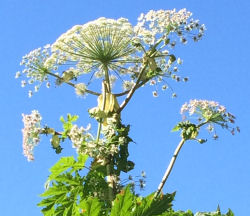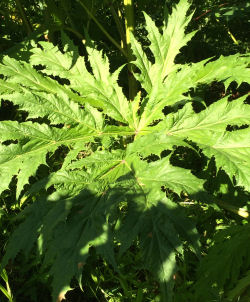|
|
|
|
|
|
| Practical ecological knowledge for the temperate reader. |
Giant Cow-Parsnip - Heracleum mantegazzianum
- Family: Apiaceae - Carrot Family [E-flora]
Severe Contact Dermatitis, Fodder
General: Similar to H. lanatum except: Biennial to perennial. Stem (1.5) 2-4.5 m tall, up to 10 cm in diameter, usually with purple blotches.[IFBC-E-flora]
Stems: Stem (1.5) 2-4.5 m tall, up to 10 cm in diameter, usually with purple blotches.
Leaves: Leaves up to 3 m long, blade to 2.6 cm wide, ternately or pinnately divided, lateral segments pinnately lobed, short-hairy below.[IFBC-E-flora]
Flowers: Inflorescence, larger ones, 20-50 cm in diameter, rays 50-150. Petals white or rarely pinkish.[IFBC-E-flora]
Fruits: Fruit blunt and rounded toward base.[IFBC-E-flora]
Introduction: "Giant hogweed (a.k.a. giant cow parsnip) is native to the Caucasus region and is introduced and invasive in Europe and North America (Krinke et al. 2005) where it is found in moist to wet disturbed sites. In North America, it is reported from several US states (CT, IL, ME, MI, NY, OR, PA, WA) and some Canadian provinces (BC, NB, ON, QC) (USDA 2010). In British Columbia, it is found in the southwestern corner of the province, along the eastern edge of Vancouver Island, on the Gulf Islands, and in the Lower Mainland. It has recently been reported in the Kootenays in the southeastern region of the province. Giant hogweed belongs to the genus Heracleum in the the carrot family (Apiaceae). This genus consists of about 80 species worldwide (found in Eurasia, east Africa, 1 in North America), and is comprised of biennial or perennial herbs with taproots or clustered roots; species in the genus may be glabrous or hairy with erect stems that are usually branched, thick, and hollow (Ganders 2010). Giant hogweed is generally a tall (1.5-5 m), distinctive species that is readily recognized by its large terminal umbels of white flowers and large leaves that are deeply divided into three palmately-lobed segments. It produces abundant seed (20,000 seeds per plant), and dies back after flowering and seed set (Marrison and Goerig 2010?). Giant hogweed is a species of concern, and a target for eradication, because it is phototoxic and can cause serious burns and painful blisters. We strongly recommend that you do not handle this plant."[E-flora]
Habitat / Range Habitat wet to moist disturbed areas in the lowlands, garden escape, well established in Vancouver, North Vancouver, West Vancouver, native to Asia. [IFBC-E-flora]
Origin Status: Exotic.[E-flora] "Introduced fromthe Russian Caucasus as an ornamental, it has now escaped to riparian areas insouth coastal BC." [Majak SPPWC]
Additional Notes "For further information about control of this species, visit the Great Vancouver Invasive Plant council web site. It is listed by them as one of the top twelve species of concern in the Vancouver Region. It is also listed by the Coastal Invasive Plant Council as one of the top fourteen species of concern on Vancouver Island and adjacent coastal areas."[E-flora]
Similar Species "Although giant hogweed is readily recognized by its very large size, smaller individuals may be mistaken for other species. In wet sites (ditches and shorelines), giant hogweed is most commonly mistaken for the native cow parsnip (Heracleum maximum). Cow parsnip ranges in height from 1-3 m and is generally a smaller plant than giant hogweed. However, the size range for the two species overlaps and small plants of giant hogweed may be mistaken for cow parsnip while taller plants of cow parsnip may be mistaken for giant hogweed. Fruit characteristics, leaf form, and number of rays in the flower umbels (15-30 rays in cow parsnip and 50-150 in giant hogweed) can readily separate these two species (see the identification key below), along with the purple blotching on the stem of giant hogweed. Additionally, cow parsnip is common and widespread throughout BC and is found at elevations up to 2750 m, while giant hogweed is not common, and is found primarily in the lowland zone in southwestern BC.
Giant hogweed is also sometimes mistaken for other species with white umbels of flowers such as poison hemlock (Conium maculatum). However, poison hemlock is generally much smaller and less robust than giant hogweed, with fern-like leaves and smaller umbels. Giant hogweed has also been mistaken for other wet-loving members of the family, so care should be taken in the identification."[E-flora]
Hazards
- Contact Dermatitis:
- This plant can cause severe dermatitis when handled [E-flora] In some cases, severe burning has resulted in tissue necrosis and extensive damage to exposed skin. [Zeng ASA]
- Even a tiny trace of the sap to an eye can singe the cornea which causes temporary or permanent blindness. [Ediblewildfood]
- The sap chemically bonds with skin when exposed to sunlight and within 48 hours can lead to inflammation, redness, itching, blisters, and eventually purplish and black scars. This is called phytophotodermatitis.[Ediblewildfood]
"The observation of photocontact dermatitis from Heracleum mantegazzianum Sommier et Levier in 2 gardeners at work prompted the analysis of furocoumarin content of stem, leaves and fruits of the plant during a period of 1 year. Their concentration was found to be maximal in fruit, intermediate in leaf, and minimal in stem. Psoralen was the most prevalent substance in the leaf and bergapten in the fruit. In the stem, in contrast, individual furocoumarins were found in lower but variable concentrations. 3 furocoumarin seasonal peaks were observed in the leaf: the maximal peak occurred in June, the intermediate in August, the minimal in November. This trend corresponds to 3 biological phases of the weed." [Pira et al.,1989]
Other Uses
- Sheep Fodder: "...grazing animals are not generally at risk. In Europe it is controlled by grazing sheep (5)." [Majak SPPWC]
Further Notes on Toxicity
"Dermatitis bullosa pratensis is frequently caused by 8-MOP that mainly occurs in the Apiaceae family (Umbelliferae), which includes plants such as the giant hogweed (Heracleum mantegazzianum) (159) and various vegetables or herbs such as celery, parsnip, and parsley (160)." [BMBBed]
"Handling of rue (Ruta graveolens;
Rutaceae) or giant hogweed (Heracleum mantegazzianum; Umbelliferae/Apiaceae), which naturally contain significant amounts
of psoralen, bergapten, and xanthotoxin, can cause similar unpleasant reactions, or more commonly rapid blistering by direct
contact with the sap. The giant hogweed can be particularly dangerous. Individuals vary in their sensitivity towards furocoumarins;
some are unaffected, whilst others tend to become sensitized by an initial exposure and then develop the allergic response on
subsequent exposures." [MNP Dewick]
Phytochemicals
Many furocoumarins are extremely toxic to fish, and some are deposited in streams in Indonesia to catch fish.[Wiki-1]
- Psoralen - (Furocoumarin)
- Distribution: "Ficus carica (fig) is probably the most abundant source of psoralens. They are also found in small quantities in Ammi visnaga (bisnaga), Pastinaca sativa (parsnip), Petroselinum crispum (parsley), Levisticum officinale (lovage), Foeniculum vulgare (fruit, i.e., fennel seeds), Daucus carota (carrot), Psoralea corylifolia (babchi), and Apium graveolens (celery).[17]" [Wiki-1]
- Psoralen is a mutagen, and is used for this purpose in molecular biology research.[1]
- "An important use of psoralen is in PUVA [Psoralen plus UVA] treatment for skin problems such as psoriasis and (to a lesser extent) eczema and vitiligo. This takes advantage of the high UV absorbance of psoralen. The psoralen is applied first to sensitise the skin, then UVA light is applied to clean up the skin problem. Psoralen has also been recommended for treating alopecia.[citation needed] Psoralens are also used in photopheresis, where they are mixed with the extracted leukocytes before UV radiation is applied."
- An additional use for optimized psoralens is for the inactivation of pathogens in blood products.
- "Despite the photocarcinogenic properties of psoralen,[3][4] it had been used as a tanning activator in sunscreens until 1996.[5] Psoralens are used in tanning accelerators, although psoralen increases the skin’s sensitivity to light. Some patients have had severe skin loss after sunbathing with psoralen-containing tanning activators.[6] Patients with lighter skin colour suffer four times as much from the melanoma-generating properties of psoralens than those with darker skin.[5]"
- Soluble in ethyl acetate or acetone; insoluble in water. [Enzo] Melting Point: 158 to 161 °C (316 to 322 °F; 431 to 434 K) [Wiki-1] "Soluble in ethanol (10 mg/ml), ethyl acetate, acetone, and water (1.93 mg/ml at 25° C)." Melting Point; 163-164 DEG C [Pubmed-1]
- "Shows antiviral, antibacterial, antifungal and insecticidal properties. Binds DNA through single and double-stranded cross-linking after photoactivation. Used as photochemical probe in studies of DNA mutation and repair mechanisms. Causes photosensitization in human." [Enzo]
- Bergapten
- "Bergapten (5-methoxypsoralen) is a psoralen (also known as furocoumarins) found in bergamot essential oil, in other citrus essential oils,[1] and in grapefruit juice.[2] It is the chemical in bergamot oil that causes phototoxicity.[3] Bergapten-free bergamot essential oil or synthetics are now used in perfumery." [Wiki-2]
- Soluble in alcohol, Melting Point; 190-193° C (lit.) Boiling Point; ~412.4° C at 760 mmHg (Predicted) [Scbt-1]
Cultivation
"The seeds of this dangerous plant may take several years to germinate and survive in the soil for up to fifteen years. Once a seed has germinated it takes two to five years of growth before the plant produces flowers. During the first year, the plant produces a rosette of leaves to 1 m high. As the plant grows a large taproot, thick hollow stems and large deeply lobed leaves are formed. Giant hogweed flowers just once in its lifetime (unless the flower clusters are damaged before opening)." [Ediblewildfood]
"Once the plant produces seed it dies. Each plant can produce up to 120,000 seeds (typically 50,000), although some of these may not be able to germinate. Seeds that make their way into streams can float for three days before becoming water logged and sink. Giant hogweed seeds are spread by wind up to 10 metres away but can travel much longer distances via water in ditches and streams." [Ediblewildfood]
References
- [2]Personal Note, May 7, 2015
- [E-flora] http://linnet.geog.ubc.ca/Atlas/Atlas.aspx?sciname=Heracleum%20mantegazzianum&redblue=Both&lifeform=7 [Accessed: 5/06/2015]
- [Ediblewildfood] http://www.ediblewildfood.com/blog/2013/07/giant-hogweed-beware/#sthash.gebWnEDP.dpuf, Accessed May 7, 2015
- [Enzo] psoralen, http://www.enzolifesciences.com/ALX-350-364/psoralen/, Accessed Sept 28, 2016
- [Pira et al.,1989] Heracleum mantegazzianum growth phases and furocoumarin content.,Pira E, Romano C, Sulotto F, Pavan I, Monaco E., Contact Dermatitis. 1989 Nov;21(5):300-3.
- [Pubmed]
- [Scbt] Santa Cruz Biotechnology
- [Wiki]
- [1] Psoralen, https://en.wikipedia.org/wiki/Psoralen, Accessed Sept 28, 2016
- [1]Wu Q, Christensen LA, Legerski RJ, Vasquez KM (June 2005). "Mismatch repair participates in error-free processing of DNA interstrand crosslinks in human cells". EMBO Rep. 6 (6): 551–7. doi:10.1038/sj.embor.7400418. PMC 1369090free to read. PMID 15891767.
- [3]M. J. Ashwood-Smith; G. A. Poulton; M. Barker; M. Mildenberger E (1980). "5-Methoxypsoralen, an ingredient in several suntan preparations, has lethal, mutagenic and clastogenic properties". Nature. 285 (5): 407–9. doi:10.1038/285407a0. PMID 6991953.
- [4]Zajdela F, Bisagni E (1981). "5-Methoxypsoralen, the melanogenic additive in suntan preparations, is tumorigenic in mice exposed to 365 nm UV radiation". Carcinogenesis. 1981 (2): 121–7. doi:10.1093/carcin/2.2.121. PMID 7273295.
- [5]Autier P.; Dore J.-F.; Cesarini J.-P. (1997). "Should subjects who used psoralen suntan activators be screened for melanoma?". Annals of Oncology. 8 (5): 435–7. doi:10.1023/A:1008205513771. PMID 9233521.
- [6]Nettelblad H, Vahlqvist C, Krysander L, Sjöberg F (December 1996). "Psoralens used for cosmetic sun tanning: an unusual cause of extensive burn injury". Burns. 22 (8): 633–5. doi:10.1016/S0305-4179(96)00028-9. PMID 8982544.
- [17]Dr. Duke's Phytochemical and Ethnobotanical Databases (on line)
- [2] Bergapten, https://en.wikipedia.org/wiki/Bergapten, Accessed Sept 28, 2016
- [1]Calvarano I.; Calvarano M.; Gionfriddo F.; Bovalo F.; Postorino E. (1995). "HPLC profile of citrus essential oils from different species and geographic origin". Essenze Derivati agrumari. 65: 488–502.
- [2]Sakamaki N.; Nakazato M.; Matsumoto H.; Hagino K.; Hirata K.; Ushiyama H. (2008). "Contents of furanocoumarins in grapefruit juice and health foods". Journal of the Food Hygienic Society of Japan. 49 (4): 326–331. doi:10.3358/shokueishi.49.326. PMID 18787320.
- [3]Francesco Gionfriddo; Enrico Postorino & Giuseppe Calabrò (2004). "Elimination of Furocoumarins in Bergamot Peel Oil". Perfumer & Flavorist. 29.
Page last modified on Monday, July 17, 2023 7:03 PM

